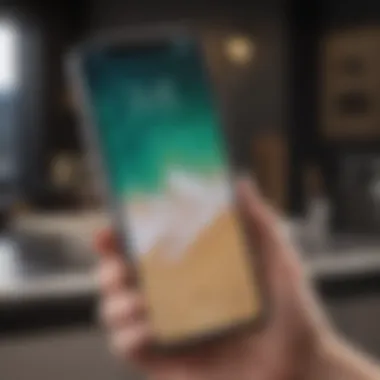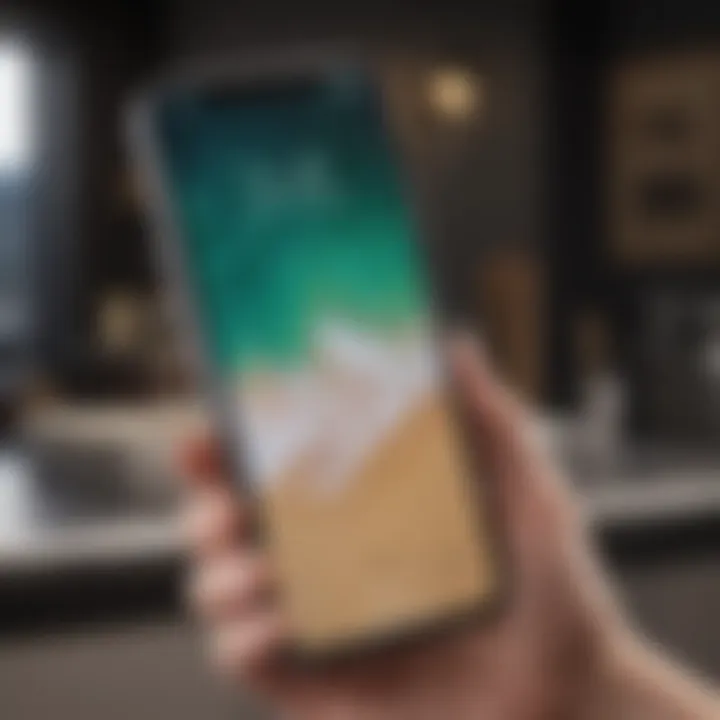Dynamic Backgrounds on iPhone: A Complete Guide


Intro
In the ever-evolving world of mobile technology, personalization has become a crucial aspect of user experience. The ability to set a moving background, often referred to as a live wallpaper, on iPhones enhances both aesthetics and functionality. This feature allows users to breathe life into their device’s interface, making it feel more dynamic and customized. For Apple aficionados and tech enthusiasts alike, understanding how to navigate this simple yet impactful adjustment adds a layer of enjoyment to the daily interaction with their devices.
With the introduction of each new iPhone model, Apple continues to refine and enhance the user interface, offering striking visual effects. This guide aims to detail how to set a moving background on your iPhone, analyze the available options, and address common challenges you may face.
Product Overview
Prelims to the Apple product being discussed
The iPhone has consistently been at the forefront of smartphone technology since its launch in 2007. Each new generation brings innovations that enhance user experience, with the latest models featuring advanced display technologies and more sophisticated software capabilities.
Key features and specifications
Recent iPhones, such as the iPhone 14 and iPhone 14 Pro, come equipped with Super Retina XDR displays, providing vibrant colors and deep contrasts. The graphics performance is further improved by the A15 Bionic chip, which supports advanced animation capabilities. These specifications create an ideal environment for utilizing moving backgrounds effectively.
Design and aesthetics
Apple’s minimalist design philosophy is evident in its products. The sleek lines and high-quality materials contribute to an aesthetic appeal that pairs well with both static and dynamic wallpapers. The moving backgrounds not only serve as a decorative element but also reflect the user’s personality and preferences.
Performance and User Experience
Performance benchmarks
The integration of live wallpapers does not significantly impact the iPhone’s performance. Tests show that even with a moving background, the device maintains smooth operation whether running applications or during system navigation. Battery performance can vary slightly, but the impact remains negligible with mindful usage.
User interface and software capabilities
iOS provides an intuitive interface for setting moving backgrounds. Users can easily navigate through the settings to select or customize their preferred wallpaper. The 'Wallpaper' section under 'Settings' allows choices between static, dynamic, and live wallpapers, showcasing Apple's focus on user-friendly design.
User experiences and feedback
Users often praise the moving backgrounds for their aesthetic value but note occasional stuttering if background actions overload the device. Overall, the feedback tends to reflect a positive response, highlighting the enhanced visual experience that live wallpapers offer.
"Setting a moving background transforms the way I engage with my phone, refreshing my experience daily."
Tips and Tricks
How-to guides and tutorials for optimizing the Apple product's performance
To set a moving background:
- Open the Settings app.
- Select Wallpaper.
- Choose Choose a New Wallpaper.
- Tap Live and select the desired wallpaper.
- Click on Set to confirm it as your wallpaper.
Hidden features and functionalities
When using live wallpapers, it’s essential to know that they often respond to device movements. This feature allows the wallpaper to create a sense of depth, resulting in a more immersive feel. Adjusting the perspective within the wallpaper’s settings enhances this experience even further.
Troubleshooting common issues
Users may encounter issues like live wallpapers not responding as intended. A few potential solutions include resetting settings, ensuring sufficient storage space, or restarting the device. Each of these actions can often resolve such problems promptly.
Latest Updates and News
Recent developments in software updates and new features
Apple periodically releases updates that enhance the iOS experience. Live wallpapers receive refinements during such updates, improving their responsiveness and overall quality. It is wise to keep your device updated to benefit from the latest features.
Industry news and rumors surrounding upcoming products
Rumors in upcoming iPhone models hint at further enhancements to live wallpapers, incorporating even more intricate animations and personalization options. Keeping an eye on Apple’s announcements can provide insights into what to expect.
Events and announcements from Apple


Apple's annual events often unveil new features and products that expand the capabilities of the iOS environment. Attending such events or following them online can provide valuable information to keen users who want the most out of their devices.
Understanding Moving Backgrounds
The significance of moving backgrounds on an iPhone extends beyond mere aesthetics. They act as a visual enhancement, transforming how users engage with their devices. In a world where technology merges with personal expression, the choice of a dynamic background can resonate with an individual's identity and preferences. This section aims to illuminate the critical components pertaining to moving backgrounds, exploring their essence and appreciating the depth they add to the user experience.
Definition and Types
Moving backgrounds, commonly referred to as live wallpapers, are images or animations that change or animate when interacted with. They differ from static wallpapers due to their ability to bring devices to life.
There are primarily two types of moving backgrounds:
- Live Wallpapers: These are animated images captured as Live Photos. They play a short video or animation when the user presses and holds the display.
- Dynamic Wallpapers: These are pre-installed or downloaded wallpapers that feature subtle animations, like shifting colors or patterns that respond to the device's movement.
Understanding these distinctions is essential. Each type offers unique features and enhances interactivity, allowing customization that reflects personal style. Moreover, recognizing the capabilities of your device will inform which options are accessible to you.
Benefits of Moving Backgrounds
Incorporating a moving background can transfigure the user interface of an iPhone. There are several notable benefits to utilizing live wallpapers:
- Enhanced Personalization: Users can express themselves better through these backgrounds, reflecting their personality and tastes.
- Aesthetic Appeal: Moving backgrounds add a layer of depth and sophistication to the device’s interface, elevating its overall appearance.
- Increased Engagement: The interactive nature of live wallpapers increases engagement with the device. Users often find themselves drawn to the beauty of moving images.
"The right wallpaper can elevate user experience and make interaction more enjoyable."
- Dynamic Experiences: Beyond just visual capture, moving backgrounds can transform the way users perceive their devices. They can elicit emotions or memories through visual storytelling.
In summary, moving backgrounds serve multiple purposes: they enrich user experience, allow self-expression, and invigorate the otherwise static state of digital screens. The combination of these advantages makes them a compelling choice for those looking to optimize their iPhone's interface.
Prerequisites for Moving Backgrounds
Understanding the prerequisites for setting a moving background on your iPhone is crucial. It ensures that you're utilizing the correct hardware and software to achieve the desired visual effects. This section delves into the necessary requirements, focusing on compatible iPhone models and specific iOS versions.
Compatible iPhone Models
Not all iPhone models support live wallpapers. For a moving background, you will need a device capable of processing and displaying Live Photos. The following iPhone models are generally compatible with this feature:
- iPhone 6s and later
- iPhone SE (1st generation)
- iPhone 7 and newer
- iPhone X and beyond
Devices older than the iPhone 6s do not have the hardware support required to run Live Photos effectively. If you own one of these compatible models, you must ensure it’s updated to benefit from the latest features associated with moving backgrounds.
iOS Version Requirements
The iOS version on your iPhone also plays a significant role in enabling moving backgrounds. Specifically, you need at least iOS 9 or later. Keeping your device updated guarantees access to optimizations and new features that enhance the moving background experience. If your current iOS version is lower than 9, you won’t be able to set a live wallpaper.
To check your iOS version, navigate to
> > . There, you will see the version number of your current operating system. If you require an upgrade, follow these steps:
> > to install the latest iOS version.
Setting a Live Wallpaper
Setting a live wallpaper can significantly enhance the visual appeal of an iPhone. Instead of static images, moving backgrounds introduce a level of dynamism that static wallpapers cannot achieve. Live wallpapers in particular provide a distinct aesthetic that makes the device feel vibrant and personalized. Furthermore, this feature allows for self-expression, allowing users to choose wallpapers that resonate with their personalities or moods.
When considering live wallpapers, it is essential to be aware of the various options available. Users can either source live wallpapers from online platforms or create their own by capturing a moment using the Live Photo feature. Regardless of the choice, setting a live wallpaper involves a few steps that, once mastered, can drastically improve daily interactions with your device.
Finding Live Wallpapers
Finding the right live wallpaper can be both exciting and overwhelming. Many users seek wallpapers that not only look beautiful but also have some emotional significance. There are several resources available for discovering high-quality live wallpapers:
- Apps: Several applications on the App Store specialize in offering collections of live wallpapers. Notable ones include Zedge and Live Wallpapers for Me. These apps often categorize wallpapers for easier searching.
- Websites: Websites such as Pinterest and Reddit often have user-generated content, allowing users to browse a wide range of choices. Be sure to check the resolution and compatibility with your iPhone model when selecting.
- Social Media: Platforms like Facebook or Instagram can also lead to promising finds. Users often share live wallpapers or can direct you to specific creators or pages.
Using these methods can help narrow down your search and ensure that the selected wallpapers align with your preferences.
Using Live Photo Options
Apple's Live Photo feature brings an even more demanding approach to setting wallpapers. When you take a Live Photo, your iPhone records a short burst of video along with the image itself. To utilize this feature for live wallpapers, follow these steps:


- Capture a Live Photo: Open the Camera app, select the Live Photo option, and take a picture. Ensure there is movement in the shot for best results.
- Access the Live Photo Gallery: Navigate to your Photos app and locate the Live Photos album.
- Select a Photo: Choose the Live Photo you want to set as your wallpaper.
- Set as Wallpaper: Tap on "Share," then select "Use as Wallpaper." You can then adjust the placement and choose to enable or disable perspective zoom.
The advantage of using Live Photos is the uniqueness they provide, as each captured moment tells a story or evokes specific feelings. Leveraging this feature fosters creativity and personalization of your device, which can reflect your everyday life.
Compiling Your Live Photo
Compiling a live photo is a crucial step for users aiming to set a moving background on their iPhone. This process allows the user to personalize their device's aesthetics effectively. The ability to capture moments in a live format opens a realm of customization far beyond standard static images. By creating a live photo, you not only immortalize a specific moment with its essence but also add a dynamic visual element to your device, making it more engaging.
Understanding how to compile a live photo encompasses both the capturing and editing phases. It is essential to pay attention to various elements, such as lighting, focus, and composition during capture to ensure that the final product is visually appealing. Additionally, editing is equally important, as it allows you to enhance the final image, adapting it to fit the aesthetic you wish to achieve. This exploration leads to a greater appreciation of the creative control one can exert on their device's appearance.
Capturing a Live Photo
Capturing a live photo on your iPhone is straightforward, yet several steps require careful consideration. First, ensure that your iPhone is in the appropriate mode to take a live photo. The live photo feature can easily be activated through the Camera app. When the camera is launched, look for the circular icon at the top of the screen. If it's yellow, the live photo feature is enabled.
- Choose your setting: Ideal settings are vital. A well-lit environment with interesting subjects increases the chances of capturing an appealing live photo.
- Frame your subject: Think about the composition. Ensure that the subject is well-framed and not obstructed by unwanted elements.
- Press the shutter: Tap the shutter button to take the photo, and hold still for a few moments to ensure the live effect captures the essence of the moment.
- Review your capture: After taking the photo, watch it play back to ensure it captured the motion you wanted.
An important tip is to explore the various modes available in the camera app, especially the portrait mode, which can create stunning depth-of-field effects that enhance the moving background.
Editing the Live Photo
Editing a live photo is just as essential as capturing it well. Once you have taken a live photo, tap on it in your Photos app to access the editing tools. Here are key considerations and steps to edit effectively:
- Open the photo: In the Photos app, select your live photo and tap 'Edit' in the top right corner.
- Trim the live effect: You can adjust the length of the live photo by dragging the sliders located at the bottom of the screen. This allows you to focus on the most dynamic part of your shot.
- Adjust exposure and color: Leveraging the editing tools in the Photos app, adjust brightness, contrast, saturation, and more to enhance the visual appeal of your live photo.
- Select your favorite frame: By swiping through the frames at the bottom of the edit screen, you can pick a still that best represents the moment. This still will be shown when you set it as a wallpaper, adding another layer of personalization.
Editing not only cleans up the composition but also prepares the live photo for use as a wallpaper. It ensures that when set as a background, it looks as striking and intentional as desired.
Applying Live Wallpapers
Applying live wallpapers to your iPhone is a pivotal aspect of personalizing your device. Not only do they enhance aesthetic appeal, but they also reflect your personality and make your experience with the device more immersive. Live wallpapers are dynamic images that have movement when you interact with your device, bringing static screens to life.
The key benefits of using live wallpapers include:
- Personalization: Users can choose wallpapers that resonate with their interests, whether it's nature, art, or abstract designs. This provides a unique touch that standard wallpapers lack.
- Visual Engagement: Engaging animations can create a more captivating environment, making every time you unlock your phone feel fresh and exciting.
- Mood Enhancement: A beautifully animated wallpaper can affect your mood positively during daily use. For example, a calming nature scene can inspire relaxation.
Before you begin setting a live wallpaper, consider the following:
- Battery Use: Live wallpapers can consume more battery compared to static ones. Understanding and monitoring your battery usage can help in managing device performance.
- Performance: Older iPhone models might struggle with high-resolution wallpapers, causing lag or slower performance. Check compatibility with your device.
Navigating to Wallpaper Settings
To start using live wallpapers, you first need to locate the wallpaper settings on your iPhone. Here’s how to do it:
- Open Settings from your home screen.
- Scroll down and tap on Wallpaper.
- Tap on Choose a New Wallpaper to access available wallpaper options.
In this section, explore various categories, including Dynamic, Stills, and Live options. Select the Live category to view your animated wallpaper choices.
Setting the Live Wallpaper
Once you have selected the live wallpaper of your choice, the next step is to set it as your background. Follow these steps:
- After selecting a live wallpaper, tap on it to see a preview. Here, you can swipe to view different options available within that category.
- Adjust the positioning and size of the image, if necessary. The iPhone allows for zooming in and repositioning the wallpaper to ensure it fits your screen as desired.
- Once satisfied with the preview, tap Set. You will see three options: Set Lock Screen, Set Home Screen, or Set Both. Choose according to your preferences.
- Afterward, you can exit Settings and return to your home screen to see the live wallpaper in action.
Setting a live wallpaper seamlessly adds character to your iPhone. Through deliberate choices, you can create an engaging experience each time you use your device.
Using Third-Party Apps for Additional Options
In the realm of mobile customization, using third-party apps can significantly enhance your experience when setting a moving background on your iPhone. While the built-in options provided by Apple are sufficient for many users, these apps offer a wider variety and often more dynamic choices that can suit individual styles and preferences. Third-party apps expand the possibilities for live wallpapers, providing unique visuals and functionalities that might not be available through standard settings.
The flexibility allowed by third-party applications is not the only benefit. Many of these apps are designed with user-friendliness in mind, making it easier to implement animations and effects that are otherwise complex to set up. Hence, users can enjoy a more personalizedfeel to their device with minimal effort. However, there are a few considerations to take into account, like compatibility with the user’s iOS version and the overall impact on device performance.
Recommended Apps for Live Wallpapers
Several third-party apps stand out for their ability to provide quality live wallpapers. Here are a few notable ones:


- Zedge: Known for its vast library of wallpapers and ringtones, Zedge offers a selection of stunning live wallpapers. Users can browse through categories and customize images per their preference.
- Walloop: This app gives users access to a wealth of animated wallpapers across various themes and styles. The interface is straightforward, making it simple to find and apply desired wallpapers.
- Live Wallpapers for Me: This app offers a huge range of live wallpapers, designed to be both engaging and aesthetically pleasing. It frequently updates its library with new content.
Before downloading any app, check its reviews and compatibility with your device. This will ensure a smoother experience and help avoid any frustration during installation.
How to Utilize Third-Party Apps
Using third-party apps to set a moving background on your iPhone is quite simple. Follow these steps to make the most of these options:
- Download the App: Go to the App Store, search for the app of your choice, and install it.
- Browse the Collection: Open the app and explore the assorted live wallpapers available. Most apps have categories or searchable tags to navigate more easily.
- Select Your Wallpaper: Once you find a wallpaper that appeals to you, tap to view it in full size. You may have the option to preview how it looks with gestures.
- Save the Wallpaper: Depending on the app, you will need to save the live wallpaper to your Camera Roll. Look for an export function within the app.
- Apply the Wallpaper: After saving it, go to your Photos app, select the live wallpaper, and set it as your lock screen or home screen wallpaper using the steps covered earlier in the guide.
Utilizing third-party apps effectively can elevate your iPhone’s aesthetic while keeping personalization at the forefront. As always, maintain awareness of updates and changes to both iOS and the apps you use to get the best results.
The world of third-party live wallpaper apps is ever-evolving, offering users the chance to truly customize their devices. Just be sure to do thorough research to find the right options that enhance, not hinder, your device’s performance.
Troubleshooting Common Issues
When setting a moving background on an iPhone, users may encounter several challenges that can interfere with their experience. It's essential to address these common issues to ensure a smooth process and complete satisfaction with the dynamic aesthetics of your device. This section will explore frequent problems, offering solutions and insights that can assist users in overcoming obstacles.
Live Photo Not Playing
One of the most prevalent issues users face is when the live photo does not play as expected. This problem can arise from various factors, such as incorrect settings, compatibility issues, or software glitches.
To begin troubleshooting:
- Check Settings: Ensure that the live wallpaper feature is enabled. Navigate to Settings > Wallpaper > Choose a New Wallpaper. Ensure you've selected a Live Photo and that the Live Photo option is active.
- Storage Space: Lack of storage can affect performance. Ensure there’s sufficient space on your device to store and playback live photos effectively. Consider deleting unnecessary files to free up space.
- Software Update: Ensure your iPhone is running the latest version of iOS. Go to Settings > General > Software Update to check for updates. Outdated software may cause compatibility issues with live wallpapers.
If these steps do not resolve the problem, restarting the device might help. This simple action often clears temporary glitches that may be interfering with the live photo playback.
Battery Drain Concerns
Another topic worth discussing is the concern about battery drain associated with using live wallpapers. Given the animated nature of these backgrounds, users are right to raise alarms about their potential impact on battery life.
Live Wallpapers can indeed consume more battery than static wallpapers. To mitigate this concern:
- Battery Usage Monitoring: Check your battery usage by going to Settings > Battery. Look for any significant impacts from the Live Photos and decide if you need to adjust usage.
- Low Power Mode: Using Low Power Mode can help preserve battery life. This option reduces background activity and can be activated in Settings > Battery > Low Power Mode.
- Alternatives: If battery life is a significant concern, consider switching to dynamic wallpapers, which still offer some motion without the intensive resource use of live wallpapers.
Ultimately, understanding how live wallpapers work and their resource implications can assist users in making informed choices about their device settings.
These troubleshooting tips should help users navigate the common issues they might face when setting a moving background on their iPhone. Addressing these points can enhance the usability and enjoyment of the device's features.
Alternatives to Live Wallpapers
Understanding alternatives to live wallpapers is significant for iPhone users who may not prefer or face issues with dynamic backgrounds. Some users appreciate the aesthetics of traditional wallpapers but still want some motion or liveliness in their device's appearance. It’s crucial to explore these options, as they provide not only a variety of visual styles but also potential benefits like improved battery life.
Dynamic Wallpapers Defined
Dynamic wallpapers offer a distinct approach to device backgrounds. Unlike traditional still images, dynamic wallpapers possess movement that enhances visual appeal without relying on the Live Photo functionality. These wallpapers change based on user interactions or time, adding some fresh character to the interface. Available on certain iPhone models, dynamic wallpapers come pre-installed with the iOS interface. Users can select from various themes, which might include subtly shifting images or patterns that create an illusion of depth, enriching user experience without compromising performance drastically.
Beneficially, dynamic wallpapers use less battery compared to live wallpapers. This is because they do not need continuous playback to operate. Rather, they only require minimal processing power to display their animated attributes when activated. This makes them a suitable option for users prioritizing efficiency over elaborate visual effects.
Static Wallpapers with Motion Effects
Static wallpapers, when combined with motion effects, bridge the gap between simple still images and heavier moving backgrounds. These wallpapers serve as a fixed foundation but can still exhibit characteristics of movement through options such as parallax or slight motion when the device is tilted. This feature can give a sense of spatial awareness and depth, expediting the visual engagement without overwhelming the device's resources.
Choosing static wallpapers with motion effects can be beneficial for users looking to maintain a cleaner aesthetic without sacrificing some flair. They are also less demanding than live wallpapers, ensuring a lower impact on battery performance while still providing a visually appealing experience. This makes them an ideal choice for those wanting efficiency, especially in scenarios where power conservation is necessary.
"Static wallpapers with motion afford an excellent balance of visual appeal and system efficiency."
Closure
In this article, we have dissected the essential elements of setting a moving background on your iPhone. Moving backgrounds can significantly enhance the aesthetic appeal of your device. They add a personalized touch and can even reflect your mood or interests. Understanding how to set these unique wallpapers is not only about following steps; it's about engaging with your device in a deeper, more meaningful way.
Recap of Key Steps
The journey to implementing a moving background involves several stages, such as:
- Identifying whether your iPhone model supports live wallpapers.
- Ensuring that your iOS version is compatible with this feature.
- Capturing or obtaining a live photo, and editing it for the best effect.
- Navigating to the wallpaper settings to apply your new background.
Each of these steps builds upon the previous one, culminating in a final product that is both eye-catching and functional.
Final Thoughts on Moving Backgrounds
Moving backgrounds serve a purpose beyond mere decoration. They enhance user experience by offering a more dynamic interaction with your device. However, users should also consider factors such as battery usage and performance impact. By thoughtfully selecting whether to use live wallpapers or dynamic options, you can optimize your device's performance while enjoying a visually stimulating environment. Understanding these aspects is crucial for discerning users looking to make their iPhones stand out.



